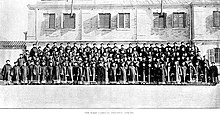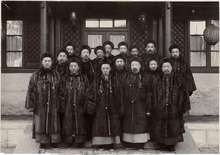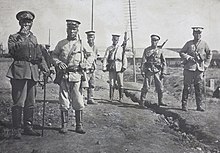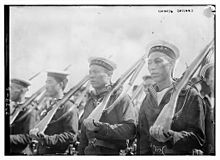Late Qing reforms
| Chinese | 晚清改革 |
|---|---|
| Type | Political system and economic reform movement |
| Period | 1901-1911 |
| Result | Failure |
| Other Chinese names | 清末新政 |
| Other English names | Cixi's New Policies Guangxu's New Policies Gengzi New Policies New Policies of the late Qing dynasty New Deal of the late Qing dynasty |
Late Qing reforms (Chinese: 晚清改革[1]; pinyin: Wǎnqīng gǎigé) , commonly known as New Policies of the late Qing dynasty[2] (Chinese: 清末新政; pinyin: Qīngmò xīnzhèng), or New Deal of the late Qing dynasty,[3] simply referred to as New Policies, were a series of cultural, economic, educational, military, and political reforms implemented in the last decade of the Qing dynasty to keep the dynasty in power after the invasions of the great powers of the Eight Nation Alliance in league with the ten provinces of the Southeast Mutual Protection in the Boxer Uprising.
Late Qing reforms started in 1901, and since they were implemented with the backing of the Empress Dowager Cixi, they are also called Cixi's New Policies.[4]
Names[]
In China, the reform is most commonly known as New Policies of the late Qing dynasty (清末新政), and is also called Gengzi New Policies (庚子新政), Post-Gengzi New Policies (庚子后新政). After the fall of the Qing Dynasty, in the Republic of China, it was called "Shame-covering reforms" (遮羞变法). In Hong Kong, it was called Late Qing reforms (晚清改革), and in Japan, it was called the Guangxu's New Policies, in reference to Emperor Guangxu (光绪新政).[5]
Politics[]
In April 1901, the Qing dynasty established the Administration Office to supervise the overall plan for reform, appointing Ronglu, Yikuang and Li Hongzhang as managers, nominating Zhang Zhidong and Liu Kunyi as coordinators. Zhang Zhidong and Liu Kunyi jointly submitted "Three folds for reform" to the imperial government, which includes setting reform direction, learning from Japan and implementing the constitutional monarchy.[6]
Five ministers went abroad to investigate[]
On January 19, 1904, viceroy of Yun-Gui Ding Zhenduo and Yunnan provincial Patrol Lin Shaonian submitted the application for political reform to the imperial government. At the beginning of the July, Viceroy of Liangjiang ask for the implementation of the "separation of the three powers" political system.
On July 2, 1905, Yuan Shikai joining with Zhou Wei and viceroy of Huguang Zhang Zhidong required imperial government to implement constitutional government in a twelve-year period. They also asked the government to assign ministers to go abroad to investigate various political formats.
On September 24, 1905, the Empress Dowager Cixi decided to assign five ministers:[7] Zhen Prince Zaize, Financial Minister Dai Hongci, Military Minister Xu Shichang, Governor of Hunan Duanfang and Prime Minister of Business Department Shaoying to go abroad. On November 25, the imperial government set up a special institution "Inspection of the political pavilion" to study the constitutional government of each country, and provide consultation on constitutional reform.
In the same year, on December 7, the first group leading by Dai Hongci and Duanfang set off at the first stop,[8] the United States, and was met by the US President Theodore Roosevelt. On January 14, 1906, the second group leading by Zaize set out. At the end of the summer, 1906, the delegation returned to China and submitted a report arguing that “The only way for state to be powerful is constitutionalism”.
On September 1, 1906, the Empress Dowager Cixi promulgated an imperial decree, announcing preparatory imitation of constitution.[9]
In 1907, the preparatory office of the Zizhengyuan Institute (Parliament) was established, and Ming Lun and Sun Jiaxuan were appointed as the presidents of the Zizhengyuan Institute. Later, Zhang Jiang and Tang Shouqian established a preparatory constitutional guild in Shanghai.[10] After that, various constitutional guilds were established in major cities all around China.
In August 1908, the imperial government published the "Constitutional Outline",[11] "The list of Preparations in next few years", and three appendices including "Civil Rights and Obligations", "The essentials of Parliament", "Election Law Essentials". These proposed laws regulated that the provincial advisory council and Central Advisory Council would be elected in the next year and the constitution was plan to prepared in nine years. On November 14th, 1908, the Emperor Guangxu died, with Empress Dowager Cixi dying the following day.

In 1909, the Qing government held parliamentary elections to the Advisory Council and provincial elections.
In 1909, after Pu Yi, the last emperor of Qing Dynasty succeeded to the throne, the provincial advisory councils were elected. In 1910, the Zizheng Institute held its first opening ceremony.

In May 1911, the prince regent Zaifeng appointed Yikuang, Prince Qing as the Prime Minister of the Imperial Cabinet to organize the new cabinet.[12] The head of the new cabinet had 13 members, including eight Manchurians, four Han Chinese, and one Mongolian. As there was seven Manchurians belonging to royal family, the cabinet was known as a "royal cabinet".
Local administrative reform[]
In 1902, Shanxi governor Zhao Erxun proposed to reform the local administrative reforms such as the Baojia system, including the establishment of the modern police system and the expansion of local organizational functions.
In 1907, the local official system was promulgated, and the financial power and military power of the governor were reduced. The Ministry of Civil Affairs owned the function of the national patrol.
Local autonomy reform measures[]
In 1906, Yuan Shikai had already established the local “Autonomous Research Institute” and the Tianjin County Council in Tianjin. In 1908, the imperial government also began to set up autonomous research institutes in the urban area, and draft the "Regulations of the Provincial Consultative Councils", which was scheduled to be completed in 1914.
Military[]
Officer training[]

In 1901, the imperial government abolished the test of traditional Chinese Martial and founded the training system for officers. Then, in 1903, the Central Training Command was established to coordinate the training of national army.[13]
Ordnance[]
In 1901, the imperial government established three arsenals in Hanyang, Shanghai, and Guangzhou.
Army[]

In 1905, the Beiyang Army was reorganized into a New Army. The imperial government originally planned to establish 500,000 regular troops in the next ten years, but until the end of 1911 (the collapse of Qing Dynasty), only about 190,000 troops had been well trained.
An edict on 15 July 1909 was passed that established the Ministry of War to control the army.[14]
[]

In 1902, Beiyang Fleet officer Sa Zhenbing proposed four methods for reviving the Imperial Chinese Navy. First, sending naval officers to study in Japan. Second, setting up a naval school in Jiangyin. Third, building Mawei Shipyard as a ship repair base. Fourth, setting up naval guard town in Yantai and Fuzhou.
Other aspects[]
The policies reformed almost every aspect of governmental affairs:
- In education, traditional academies became western-style schools and abolished the imperial examinations. Each province established a military academy.
- A new code and judicial system came in law. The system of fiscal control and tax collection expanded and regularized, an especially important task since the Boxer Indemnity required payments to foreign powers which exceeded the annual income of the national government.
- Local and regional police forces were organized, with model prisons opened.[15]
Evaluation[]
The impact of these reforms varied from place to place. Many regions were virtually unchanged, while the provinces in the lower Yangzi valley had already taken the lead. The province of Zhili (roughly present day Hebei) was a model. With the strong support of the Empress Dowager, Yuan Shikai set up a strong bureaucracy to administer tax collection, local schools and police.[16]
However, there is still debate among the academic community regarding the actual effect that these reforms had on the Chinese people, historian Immanuel Hsü claiming that, apart from the successes in "...the abolition of the civil service examinations… the establishment of modern schools… and the sending of students abroad…”,[17] the reforms were "…essentially a noisy demonstration without much substance or promise of accomplishment…".[18] However, other historians, such as Diana Preston, place much greater weight on the influence of these reforms on the later development of China in its progression towards a more 'developed' society, contending that "…the events of 1900 and their aftermath precipitated reforms that, albeit late [and] grudging, were far-reaching and laid the foundations for a modern state…".[19]
On 22 July 1908 the Qing government issued the Principles of the Constitution (Qinding Xianfa Dagang), modeled on the Japanese Meiji Constitution, which provided for gradual introduction of an electoral system beginning with local elections in 1908, followed in two years by elections for provincial legislatures, then two years later, elections for a national assembly. Special bureaus were set up in each province to prepare for setting up assemblies, directly subordinated to the provincial governor and consisting of scholars and gentry. They set up regulations for carrying out the elections, a timetable for carrying them out, and notices. The first to hold elections for the provincial assembly was the Jiangsu province, in 1909, and elections occurred on time in all provinces except for Xinjiang.[20]
The New Policies also resulted in drastic change of the Manchu policy toward Mongolia from a relatively conservative-protective one to an aggressive-colonial one.[21]
The New Policies are judged now to have been a substantive beginning for China's reorganization which was destroyed after the death of the Dowager Empress in 1908 by the intransigent stand of conservative Manchus in the Qing court.
See also[]
- Self-Strengthening Movement
- Hundred Days' Reform
- Mongolia under Qing rule
- Xinhai Revolution
References[]
Citations[]
- ^ "History of Modern East Asia". National Taiwan University. Retrieved 28 March 2021.
- ^ Yih-Jye Hwang (2015-01-23). "The births of International Studies in China". Review of International Studies.
- ^ Eva Huang; John Benson; Ying Zhu (17 March 2016). Teacher Management in China: The Transformation of Educational Systems. Routledge. pp. 32–. ISBN 978-1-317-43514-3.
- ^ China Review International. University of Hawaiʻi, Center for Chinese Studies and University of Hawaii Press. 2003.
- ^ "A Study of the Five Ministers' Overseas Study Tour at the End of Qing Dynasty" (PDF). Institute of Social Science of the University of Tokyo. 2011-03-23.
- ^ Esherick, Joseph, W. (2012). "Reconsidering 1911: Lessons of a sudden revolution". Journal of Modern Chinese History. 6 (1): 1–14. doi:10.1080/17535654.2012.670511. S2CID 143236087.
- ^ Bian, Xiuquan (2003). Constitutionalism and legal reform in the late Qing Dynasty. Beijing: China Social Sciences Press. ISBN 9787500438366.
- ^ Hou, Yijie (1993). The Trend of China's Political Reform in the Early 20th Century: The History of the Constitutional Movement in the Late Qing Dynasty. Beijing: People's Publishing Press. ISBN 9787300110288.
- ^ Li, Tiancheng (2001). Chinese History Dictionary. Yanbing: Yanbian People's Publishing Press. ISBN 9787806483855.
- ^ Perspective of Old Shanghai: A Study of Shanghai History of Chinese and Japanese Young Scholars. Shanghai: Shanghai Academy of Social Sciences Press. 2004. ISBN 9787806814994.
- ^ Long, Chengwu (2011). Xin hai : guo yun 1911 (Di 1 ban ed.). Zhongguo min zhu fa zhi chu ban she. ISBN 9787802199095.
- ^ Li, Jinhe (2007). Zhongguo zheng dang zheng zhi yan jiu, 1905–1949 (Di 1 ban ed.). Beijing: Zhong yang bian yi chu ban she. ISBN 9787802112940.
- ^ Christine Moll-Murata and Ulrich Theobald (2013). "Military Employment in Qing Dynasty China". Fighting for a Living. Amsterdam: Amsterdam University Press: 353–392. ISBN 9789089644527. JSTOR j.ctt6wp6pg.15.CS1 maint: uses authors parameter (link)
- ^ Chisholm, Hugh, ed. (1911). . Encyclopædia Britannica (11th ed.). Cambridge University Press.
- ^ Reynolds (1993).
- ^ MacKinnon (1980).
- ^ Hsü, I 2000, The Rise of Modern China, 6th edn, Oxford University Press, New York. p.412
- ^ Hsü, I 2000, The Rise of Modern China, 6th edn, Oxford University Press, New York. p.412
- ^ Preston, D 2000, The Boxer Rebellion The Dramatic Story of China's War on Foreigners That Shook the World in the Summer of 1900, 1 edn, Bloomsbury Publishing, London., p.364.
- ^ EsherickWei (2013).
- ^ Mongolia in the Twentieth Century: Landlocked Cosmopolitan, pp. 39-41
Sources[]
- Esherick, Joseph; Wei, George C.X, eds. (2013). China: How the Empire Fell. New York, NY: Routledge. ISBN 978-0-415-83101-7.
- MacKinnon, Stephen R. (1980). Power and Politics in Late Imperial China: Yuan Shi-kai in Beijing and Tianjin, 1901–1908. Berkeley, CA: University of California Press. ISBN 978-0-520-04025-0.
- Reynolds, Douglas (1993). China, 1898–1912: The Xinzheng Revolution and Japan. Cambridge, MA: Council on East Asian Studies Harvard University: Distributed by Harvard University Press. ISBN 978-0-674-11660-3.
- Rhoads, Edward J. M. (2000). Manchus & Han : Ethnic Relations and Political Power in Late Qing and Early Republican China, 1861-1928. Seattle: University of Washington Press. ISBN 0295979380.
- Shan, Patrick Fuliang (2018). Yuan Shikai: A Reappraisal. The University of British Columbia Press. ISBN 9780774837781.
- Government of the Qing dynasty
- Reform in China